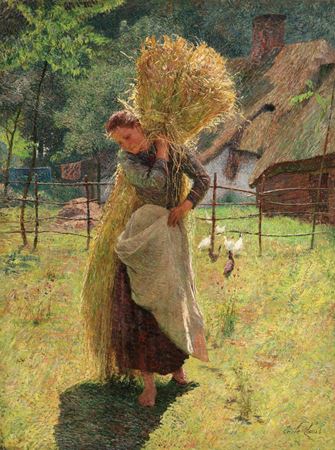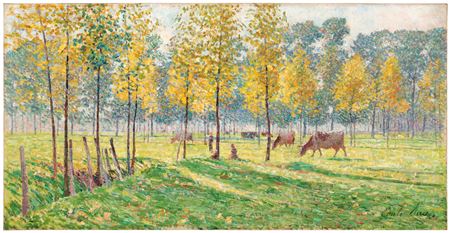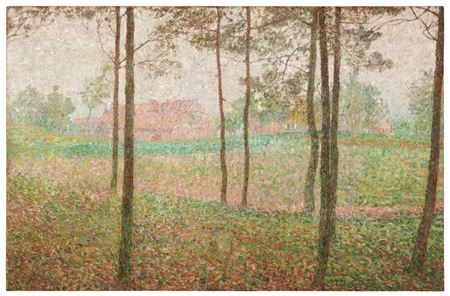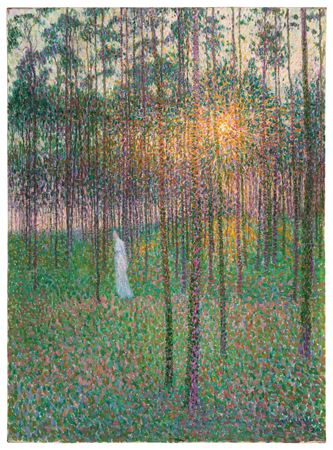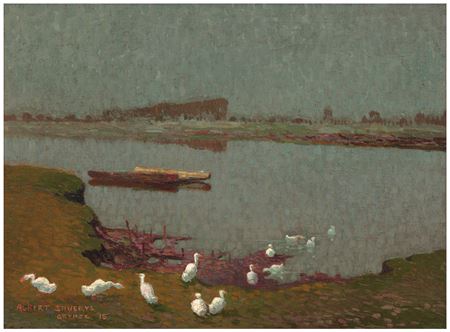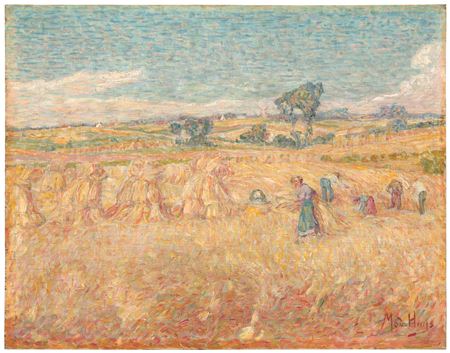- 1911, Salon de Paris, no. 287.
- 1974, Retrospectieve tentoonstelling Emile Claus 1849-1924, Ghent, Museum of Fine Arts, cat. p. 58, XXVII, cat. no. 111.
Emile Claus
(1849-1924)Villa Zonneschyn in spring
1910Oil on canvas
140 x 202 cm (55¹/₈ x 79¹/₂ inches)
With frame: 159 x 221 cm (62 ⁵/₈" x 87")
Signed lower left: Emile Claus
Signed lower left: Emile Claus
Contact Us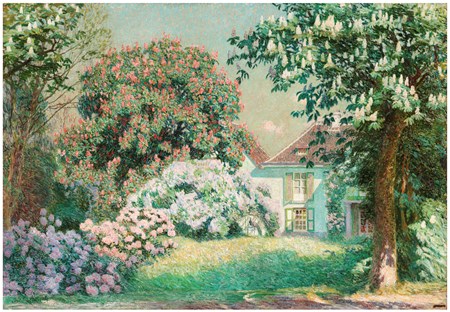
Literature


- Delen, A., "Emile Claus", à: P. Buschmann, L'Art Flamand & Hollandais, jrg. 8, nr. 11 (Bruxelles: G. Van Oest, 1911), p. 140, 194 (ill.).
- Buysse, C., Emile Claus, mon frère de Flandre (Gand: Van Rysselberghe & Rombaut, 1926), p. 56 (ill.).
- Kunst, no. 1 (Gand: André Vyncke, 1930), p. 9-23 (ill. p. 20).
- Eeckhout, P., Retrospectieve tentoonstelling Emile Claus 1849-1924, exh. cat. (Gent: Museum voor Schone Kunsten, 1974), cat.no. 111 (ill.).
- Boyens, P., Sint-Martens-Latem: Kunstenaarsdorp in Vlaanderen (Tielt: Lannoo, 1992), p. 538 (ill.).
- Pauwels, P.J.H., Comme un miroir étincelant (Sint-Martens-Latem: Galerie Oscar De Vos, 2019), p. 87 (ill.).
- Buysse, C., Emile Claus, mon frère de Flandre (Gand: Van Rysselberghe & Rombaut, 1926), p. 56 (ill.).
- Kunst, no. 1 (Gand: André Vyncke, 1930), p. 9-23 (ill. p. 20).
- Eeckhout, P., Retrospectieve tentoonstelling Emile Claus 1849-1924, exh. cat. (Gent: Museum voor Schone Kunsten, 1974), cat.no. 111 (ill.).
- Boyens, P., Sint-Martens-Latem: Kunstenaarsdorp in Vlaanderen (Tielt: Lannoo, 1992), p. 538 (ill.).
- Pauwels, P.J.H., Comme un miroir étincelant (Sint-Martens-Latem: Galerie Oscar De Vos, 2019), p. 87 (ill.).
Exhibitions


Description


Villa Zonneschijn and the surrounding garden were given an important place in the work of Emile Claus from around 1895 onwards. In Claus' day, the garden on the street side consisted of an area of wild grasses that were 'cultivated' as such, as contemporary photographs and postcards, as well as this painting, show. Around the house were flower bushes with anemones, azaleas, dahlias, hydrangeas, poppies, nightshades, and also wild flowers, including yarrow and star flowers. The garden was dominated by an impressive chestnut tree, some beeches and an old fir tree. To the right of the house was an orchard, with a vegetable garden and a meadow behind it. The garden was the domain of Charlotte Claus-Du Faux, the painter's wife, assisted by a gardener.
In this view of Villa Zonneschijn, Claus focused on the spacious garden around his house, which stretches between the Leie and the Gentse steenweg (the present Emile Clauslaan). The wealth of flowers provided a welcome opportunity for the painter to combine a particularly free touch with an unprecedented wealth of colour and a somewhat unusual perspective view. The flower bushes give rise to various plans. In the foreground on the left, they form an introduction, and in the further perspective, they are presented as a screen that partly hides the house and almost completely the studio on the left. Another typical feature of Claus' luminism is the play of light. The sunlight comes from the right and here a tree forms the backdrop. The foliage of the trees to the right of the house casts a wide shadow. The gabled roof of the porch casts a straight line of shadow on the façade and creates an imaginary triangle which, in addition to the line of shadow, is further formed by the eaves and closed off, imaginary, by the wildflower bush painted in delicate purple in front of the studio. That flower bush gives a small view through to the wall of the studio in which one of the painter's peacocks can be seen. It is clear from the above that Claus paid particular attention to the composition. It makes the painting one of the most successful views of his Garden of Eden.
Description on frame: Maison printemps
Description on reverse of the canvas: meij - A.J. / E.C.
Exhibition label
In this view of Villa Zonneschijn, Claus focused on the spacious garden around his house, which stretches between the Leie and the Gentse steenweg (the present Emile Clauslaan). The wealth of flowers provided a welcome opportunity for the painter to combine a particularly free touch with an unprecedented wealth of colour and a somewhat unusual perspective view. The flower bushes give rise to various plans. In the foreground on the left, they form an introduction, and in the further perspective, they are presented as a screen that partly hides the house and almost completely the studio on the left. Another typical feature of Claus' luminism is the play of light. The sunlight comes from the right and here a tree forms the backdrop. The foliage of the trees to the right of the house casts a wide shadow. The gabled roof of the porch casts a straight line of shadow on the façade and creates an imaginary triangle which, in addition to the line of shadow, is further formed by the eaves and closed off, imaginary, by the wildflower bush painted in delicate purple in front of the studio. That flower bush gives a small view through to the wall of the studio in which one of the painter's peacocks can be seen. It is clear from the above that Claus paid particular attention to the composition. It makes the painting one of the most successful views of his Garden of Eden.
Description on frame: Maison printemps
Description on reverse of the canvas: meij - A.J. / E.C.
Exhibition label
You May Also Like




